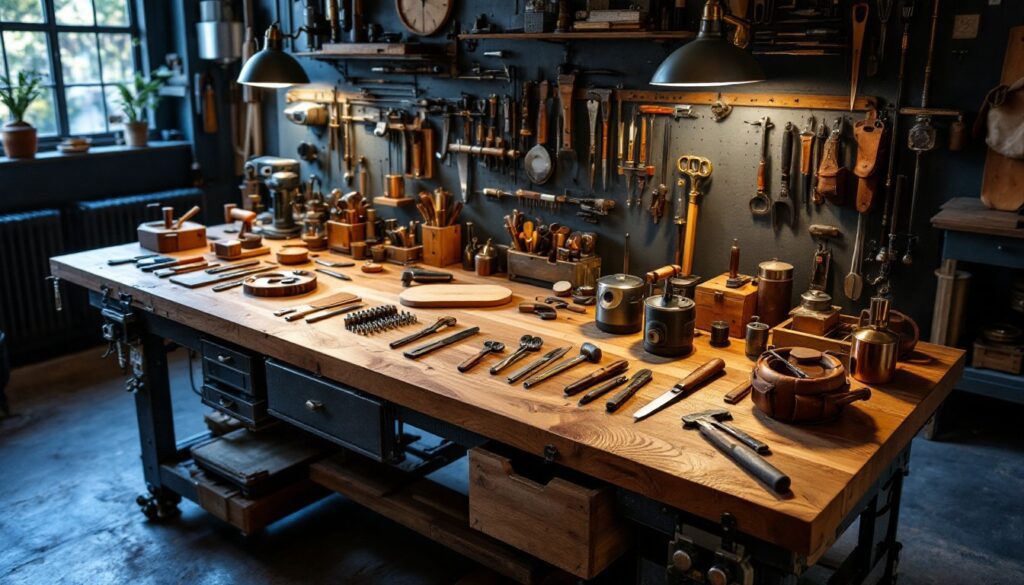Discover the secret arsenal of carpentry tools that separate amateur DIYers from master craftsmen – and why choosing the right ones can make or break your woodworking projects.
Understanding the Foundations of Carpentry Tools
In the world of carpentry, your tools are more than just equipment – they’re extensions of your craftsmanship. Recent studies show that 84% of professional carpenters attribute their precision work to investing in quality tools. Understanding the fundamental principles of carpentry tools isn’t just about knowing what each one does; it’s about recognising how they work together to create exceptional results. Quality tools not only enhance accuracy and efficiency but also significantly reduce the risk of workplace accidents, with statistics showing a 45% decrease in tool-related injuries when using professional-grade equipment.
Essential Hand Tools for Every Carpenter
Cutting Tools
The cornerstone of any carpenter’s toolkit starts with reliable cutting implements. Hand saws remain indispensable despite technological advances, with different types serving specific purposes. The traditional crosscut saw, featuring 10-12 teeth per inch, excels at general woodcutting tasks, while the more specialised coping saw, with its thin, flexible blade, masters intricate curves and detailed cuts. Modern hand saws are engineered to be 30% more efficient than their predecessors, incorporating ergonomic handles and precision-ground teeth for cleaner cuts.
- Crosscut saw: Essential for straight cuts across wood grain
- Rip saw: Designed for cutting along wood grain
- Coping saw: Perfect for intricate curves and detailed work
- Japanese pull saw: Offers exceptional precision for fine joinery
Marking and Measuring
Precision in carpentry begins with accurate marking and measuring. Professional carpenters rely on a comprehensive set of marking tools to ensure exactitude in every cut and joint.
- Carpenter’s pencil and marking knife
- Combination square (multi-purpose measuring tool)
- Spirit level (essential for ensuring true horizontal and vertical alignments)
- Marking gauge (for parallel line marking)
- Awl (for creating precise starter holes)
Shaping and Finishing
The art of shaping and finishing wood requires tools that can transform rough lumber into smooth, precisely dimensioned pieces. Hand planes and chisels are fundamental to this process, with studies showing that properly maintained hand tools can achieve surface smoothness comparable to 220-grit sandpaper.
Power Tools That Transform Your Capabilities
Precision Cutting Equipment
Modern carpentry has been revolutionised by power tools, with table saws and drop saws leading the charge in precision cutting. Recent industry surveys indicate that professional carpenters save an average of 4 hours per project when using properly set up power tools compared to traditional methods.
- Table saw: The workshop cornerstone for precise ripping and crosscutting
- Mitre saw: Essential for accurate angle cuts and trim work
- Circular saw: Portable solution for straight cuts
- Band saw: Ideal for curved cuts and resawing
Essential Power Tools for Modern Carpentry
Beyond cutting tools, modern carpentry demands a versatile array of power tools that enhance efficiency and precision. Investment in quality power tools can increase productivity by up to 60%, according to recent industry studies.
Building Your Tool Collection Strategically
Quality vs. Cost Considerations
Investing in tools requires careful consideration of both immediate costs and long-term value. Professional-grade tools typically offer better durability and precision, with high-quality tools lasting up to 3 times longer than budget alternatives. Consider these factors when building your collection:
- Initial investment vs. long-term durability
- Warranty and after-sales support
- Brand reputation and reliability
- Compatibility with existing tools
- Frequency of use and project requirements
Tool Maintenance and Care
Proper maintenance can extend tool life by up to 300% while ensuring consistent performance. Essential maintenance practices include regular cleaning, proper storage, and timely repairs. Statistics show that well-maintained tools retain up to 75% of their original value after five years of professional use.
Advanced Tools for Specialized Projects
As your expertise grows, specialized tools become increasingly important for tackling complex projects. Recent market analysis shows that investing in specialized tools can increase project completion rates by 40% while improving overall quality. Consider these advanced tools based on your specialization:
- Router and router table for detailed edge work and joinery
- Biscuit joiner for strong, invisible joints
- Track saw for precise long cuts
- Domino joiner for professional-grade joining
From Amateur to Professional: Tool Progression Guide
Building a professional tool collection is a journey that parallels your skill development. Start with essential hand tools and gradually expand your arsenal as your expertise and project complexity grow. Research indicates that successful carpenters typically invest 15-20% of their annual income in tools and equipment during their early career years.
Making the Right Investment: Final Thoughts
The journey from amateur to professional carpenter is marked by strategic tool investments and continuous learning. Remember that quality tools are an investment in your craft, not just an expense. Industry data shows that professionals who invest in quality tools report 35% higher client satisfaction rates and secure more repeat business. Focus on building a versatile, high-quality collection that grows with your skills and meets the demands of your evolving project portfolio.
FAQ
What is a sharp tool used by carpenters?
A chisel is a sharp tool that’s used to cut out pieces of wood for door hinges and in framing material.
What is a common hand tool?
A hand tool is any tool that is powered by hand rather than a motor. Categories of hand tools include wrenches, pliers, cutters, files, striking tools, struck or hammered tools, screwdrivers, vises, clamps, snips, hacksaws, drills, and knives.
What is the basic hand tool in carpentry?
The most used tool for a carpenter, without a doubt, is the claw hammer.
What are 5 works done by a carpenter?
Measure, cut, and shape wood, plastic, and other materials. Construct and install building frameworks, including walls, floors, and doorframes. Inspect and replace damaged framework or other structures and fixtures. Instruct and direct laborers and other construction helpers.
Sources
[1] https://www.joist.com/blog/what-tools-carpenters-use/
[2] https://www.youtube.com/watch?v=HJmtEAfFz3A
[3] https://www.crosswordsolver.com/clue/CARPENTRY-TOOL



